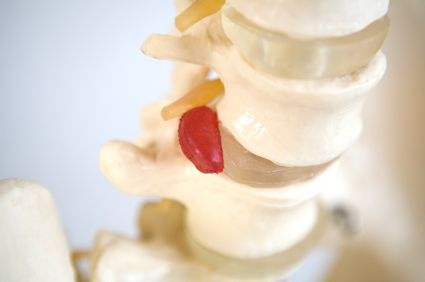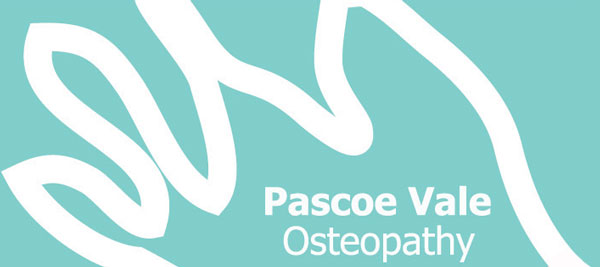Disc Bulges
Written by Dr. David Howard – B.Sc. (Clinical Sci.), M.H.Sc. (Osteopathy), B.App.Sc (Human Movement) from Pascoe Vale Osteopathy located in Pascoe Vale, Melbourne, Victoria, Australia.
Other common names for a disc bulge are: disc prolapse, disc herniation,  blown disk, slipped disc and pinched nerve.
blown disk, slipped disc and pinched nerve.
A Doughnut…
We first need to understand a little more about the disc. The best way to describe it is a comparison to a jam doughnut!
The disc is made up of a strong outer layer (the crusty outside), lots of water (the soft, squishy dough) with an inner core or nucleus (the jam).
Moving Disc
With a doughnut, the jam can be squeezed around depending on where you put the pressure on the bun. If you squeeze it too hard, then the jam will likely escape.
It is just the same with the disc. When you bend forwards or sit down, the pressure is placed on the front part of the disc. This has the effect of squeezing the disc core (shown in red in the picture) backwards. The more bending forward or sitting you do, the more you are encouraging the disc material to move in a backward direction.
If you decide to lift something with your back bent, then you are adding a tremendous force to your disc. Basically you are asking for trouble!
Prolapse, Herniation, Bulge… it’s all the same thing!
And so, if pressure is placed onto a part of the disc, the central core material will be squeezed to the area of least pressure (away from where it is being squashed/compressed).
If there is too much pressure on the disc or too frequent high pressure on the disc, it can bulge out into the outer wall. This is when you get a disc bulge, prolapsed disc or slipped disc! This bulge in the disc can then press on the spinal cord or nerves as they pass out from the spine. This pressure on the nerve effects its ability to function causing pain, numbness, tingling and weakness.
Symptoms
Symptoms of a prolapsed disc can vary widely. They can range from simple localised lower back pain to very intense leg pain, weakness, numbness and/or pins and needles. The leg symptoms are most commonly down the back of the thigh, the outer side of the leg and the top of the foot. You may have difficulty walking due to muscle weakness or spasm. The symptoms tend to get worse with sitting, sneezing, coughing and going to the toilet as there is extra pressure on the disc and therefore also the neural structures (nerves). Disc bulges can occur in any age group but are most common between the ages of 20-45 when the disc is most mobile and hydrated. Unlike the typical ‘movie version’ of someone lifting a heavy weight and then collapsing on the ground, the most common way that the symptoms start is actually the next day after lifting something heavy. Patients commonly wake up not being able to move and in pain.
Treatment
Treatment is usually conservative with manual therapy such as osteopathic treatment to get everything around the affected disc moving/healthy to decrease the pressure/work-load on the disc. However, in severe cases, especially those involving chronic pain (longer than 3 months) and muscle weakness, surgery may be required. Exercise such as core strengthening and swimming are of great benefit. Anti-inflammatories and ice can help control the symptoms. In general, it can take about 12-24 weeks for disc bulge symptoms to abate however there will be a weakness in the disc for the rest of the patient’s life. Regular treatment and strengthening exercises will be needed to help prevent reoccurance/flare-ups.
How do I prevent it??
*Get regular maintenance osteopathic treatment, especially if you lift often in your day to day life such as trades-people and parents of young children. Treatment will ensure that all of your joints are working properly so that one joint isn’t getting most of the load.
*Use good lifting technique. This means using your legs, not your back! Rather then bending at the hips and back to pick up your child, bend at your knees keeping your back straight!
*Tighten your core stabilising muscles whenever you lift something. If you don’t know how to do this, ask Dr. David Howard next time you have an appointment or start clinical pilates.
*Stretch – REGULARLY. My definition of ‘regularly’ is every day. It doesn’t have to be for long – simple and frequent is better than complicated and infrequent!
*Keep your weight within the healthy range for your age and height. Being overweight puts much more strain on your joints and discs which increases the chance of a bulge.
Disclaimer: Information provided in this post is of a general nature and should not be used solely in place of individual advice from either myself or another medical professional. Pascoe Vale Osteopathy and Dr. David Howard will not take responsibility for any injury resulting from following information in this post.
Pascoe Vale Osteopathy provides osteopathic services to patients from a wide number of suburbs such as Pascoe Vale, Essendon, Essendon North, Moonee Ponds, Strathmore, Niddrie, Keilor, Coburg, Brunswick, Oak Park, Glenroy, Airport West, Travancore, Melbourne, Australia.
